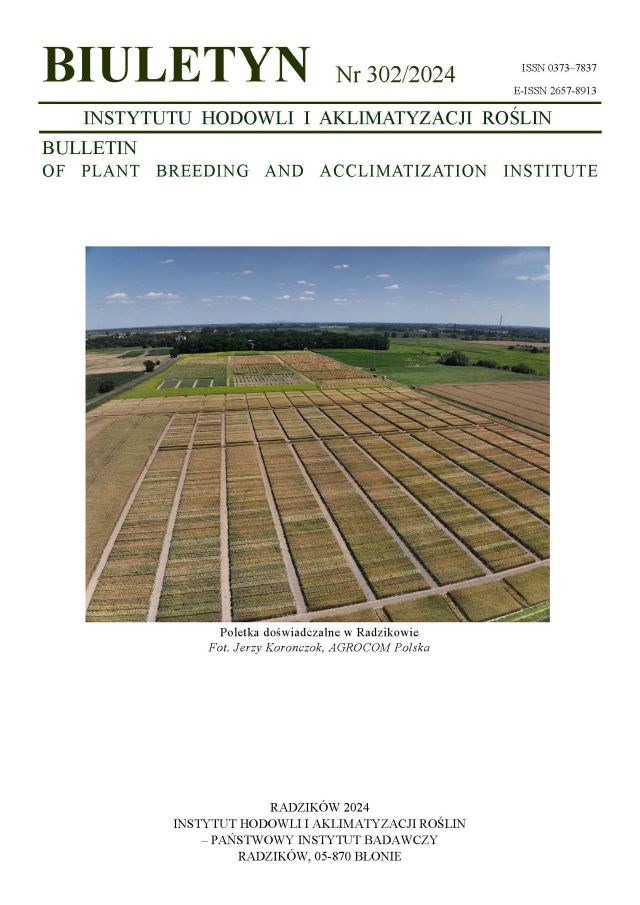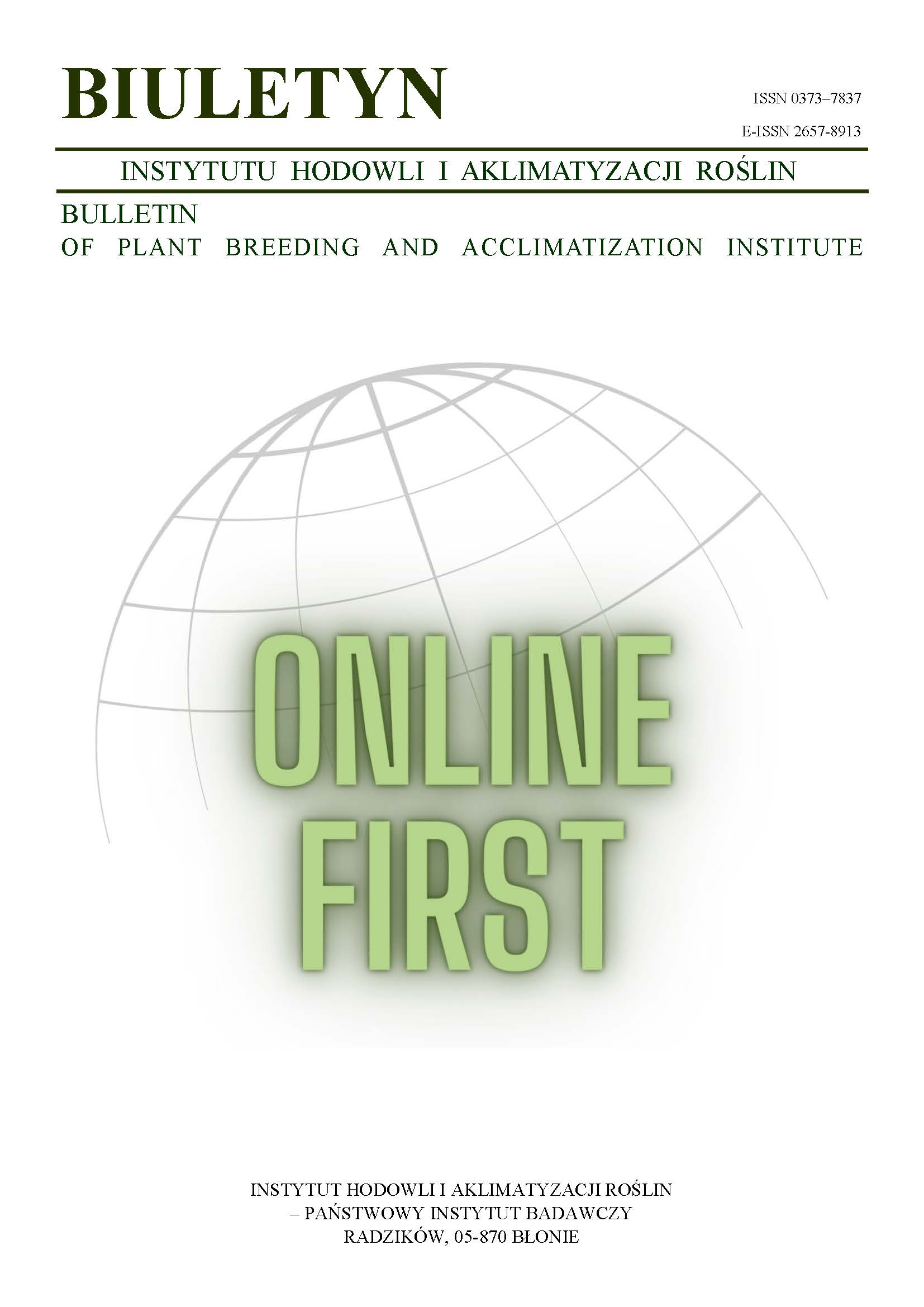Effect of cultivar and seeding rate on grain yield, its structure and morphotype of spring triticale
Elżbieta Pisulewska
kszur@urk.edu.plKatedra Szczegółowej Uprawy Roślin, Akademia Rolnicza w Krakowie (Poland)
Marek Kołodziejczyk
Katedra Szczegółowej Uprawy Roślin, Akademia Rolnicza w Krakowie (Poland)
Robert Witkowicz
Katedra Szczegółowej Uprawy Roślin, Akademia Rolnicza w Krakowie (Poland)
Abstract
Two-factorial field experiments were conducted at the Prusy Experiment Station near Kraków from 1999 to 2001. They involved three spring triticale cultivars (Migo, Kargo and Wanad) and two seeding rates (400 and 500 kernels per m2). The soil type was degraded chernozem classified as the very good wheat complex. The grain yields of spring triticale varied between years and were affected by cultivars and seeding rates. Of the studied cultivars, Kargo gave higher yields than Migo (+8.2 dt/ha) and Wanad (+5.4 dt/ha). The grain yields of Kargo i Migo were increased by higher seeding rates. Cultivar had a significant effect on 1000-grain weight. Less apparent effects of cultivar were observed for the degree of tillering, length of ears and height of plants. No effect of cultivar was noted for the number of spikelets and kernels in an ear. Seeding rate significantly modified the components of yield structure and characteristics of spring triticale morphotype. Increasing seeding rate resulted in higher number of ears per area unit, higher 1000-grain weight and enhanced height of plants. In contrast, number of spikelets and kernels in an ear and its length were decreased.
Keywords:
grain yield, morphotype, seeding rate, spring triticale, yield structureReferences
Budzyński W., Korona E. 1994. Wpływ gęstości siewu na plonowanie pszenżyta jarego. Zesz. Nauk. AR Szczec., Rol. 162: 19 — 22.
Google Scholar
Chrzanowska-Drożdż B., Liszewski M. 2000. Reakcja pszenżyta jarego Migo i Gabo na gęstość siewu. Folia Univ. Agric. Stetin. 206 Agricultura (82): 39 — 44.
Google Scholar
Czerednik A., Łoboda T., Dalbiak A., Pietkiewicz S., Nalborczyk E. 1997. Analiza wzrostu i struktura plonu różnych morfotypów pszenżyta ozimego (X Triticosecale Wittmack). Zesz. Nauk. AR Szczec. Rol. 175: 79 — 84.
Google Scholar
Jaśkiewicz B., Mazurek J. 1997. Wpływ obsady na plonowanie i architekturę łanu trzech odmian pszenżyta ozimego. Zesz. Nauk. AR Szczec. Rol. 175: 135 — 141.
Google Scholar
Jaśkiewicz B., Mazurek J. 2000. Produkcyjność pszenżyta jarego przy różnych technikach nawożenia azotem i gęstości siewu. Folia Univ. Agric. Stetin. 206 Agricultura (82): 105 — 108.
Google Scholar
Koczowska I., Korona A. 1994. Zmienność i korelacja wybranych cech pszenżyta jarego. Zesz. Nauk. AR Szczec. 162 Rol. 58: 67 — 72.
Google Scholar
Mazurek J., Nieróbca P. 1998. Wpływ czynników agrotechnicznych na plon i elementy struktury plonu pszenżyta jarego. Biul. IHAR 205/206: 175 — 179.
Google Scholar
Mazurek J., Nieróbca P. 2000. Wpływ nawożenia azotowego, terminu siewu i ilości wysiewu na plon i elementy struktury plonu pszenżyta jarego. Biul. IHAR 214: 111 — 114.
Google Scholar
Podolska G., Wielgo B. 1997. Produktywność pszenżyta ozimego w zależności od modelu morfologicznego rośliny. Zesz. Nauk. AR Szczec. 175, Rol. 65: 341 — 347.
Google Scholar
Rudnicki F., Jaskulski D., Kotwica K. 1997. Zależność plonu pszenżyta jarego od gęstości siewu i ilości opadów. Zesz. Nauk. AR Szczec. 175 Rol. 65: 379 — 385.
Google Scholar
Stankowski S. 1994. Reakcja pszenżyta jarego na termin siewu, ilość wysiewu, rozstawę rzędów i głębokość siewu w uprawie na glebie lekkiej. Rozpr. AR Szczec. 159.
Google Scholar
Wojnowska T., Budzyński W., Koc J. 1997. Reakcja pszenżyta jarego na gęstość siewu i nawożenie azotem. Cz. I. Struktura plonu. Cz. II. Plonowanie pszenżyta. Zesz. Nauk. AR Szczec. Rol. 175: 473 — 489.
Google Scholar
Wojnowska T., Budzyński W., Koc J., Szymczyk S., Pilejczyk D. 1997. Rola czynników agrotechnicznych w kształtowaniu plonu i jego struktury oraz cech biometrycznych pszenżyta jarego. Cz. I. Struktura plonu. Zesz. Nauk. AR Szczec. 175 Rol. 65: 481 — 487.
Google Scholar
Zych J. 2001. Pszenżyto jare, synteza wyników doświadczeń rejestrowych. COBORU, Słupia Wielka.
Google Scholar
Authors
Elżbieta Pisulewskakszur@urk.edu.pl
Katedra Szczegółowej Uprawy Roślin, Akademia Rolnicza w Krakowie Poland
Authors
Marek KołodziejczykKatedra Szczegółowej Uprawy Roślin, Akademia Rolnicza w Krakowie Poland
Authors
Robert WitkowiczKatedra Szczegółowej Uprawy Roślin, Akademia Rolnicza w Krakowie Poland
Statistics
Abstract views: 68PDF downloads: 30
License
Copyright (c) 2004 Elżbieta Pisulewska, Marek Kołodziejczyk, Robert Witkowicz

This work is licensed under a Creative Commons Attribution-ShareAlike 4.0 International License.
Upon submitting the article, the Authors grant the Publisher a non-exclusive and free license to use the article for an indefinite period of time throughout the world in the following fields of use:
- Production and reproduction of copies of the article using a specific technique, including printing and digital technology.
- Placing on the market, lending or renting the original or copies of the article.
- Public performance, exhibition, display, reproduction, broadcasting and re-broadcasting, as well as making the article publicly available in such a way that everyone can access it at a place and time of their choice.
- Including the article in a collective work.
- Uploading an article in electronic form to electronic platforms or otherwise introducing an article in electronic form to the Internet or other network.
- Dissemination of the article in electronic form on the Internet or other network, in collective work as well as independently.
- Making the article available in an electronic version in such a way that everyone can access it at a place and time of their choice, in particular via the Internet.
Authors by sending a request for publication:
- They consent to the publication of the article in the journal,
- They agree to give the publication a DOI (Digital Object Identifier),
- They undertake to comply with the publishing house's code of ethics in accordance with the guidelines of the Committee on Publication Ethics (COPE), (http://ihar.edu.pl/biblioteka_i_wydawnictwa.php),
- They consent to the articles being made available in electronic form under the CC BY-SA 4.0 license, in open access,
- They agree to send article metadata to commercial and non-commercial journal indexing databases.
Most read articles by the same author(s)
- Marek Kołodziejczyk, Phenotypic variation of yielding of medium-early cultivars of edible potato , Bulletin of Plant Breeding and Acclimatization Institute: No. 294 (2021): Regular issue
- Elżbieta Pisulewska, Julita Maciejewicz-Ryś, Halina Góral, Yield, chemical composition and protein quality in long flower head forms of red clover (Trifolium pratense L.) , Bulletin of Plant Breeding and Acclimatization Institute: No. 228 (2003): Regular issue
- Halina Gambuś, Florian Gambuś, Elżbieta Pisulewska, Oats wholemeal as a source of dietary elements in wheat bread , Bulletin of Plant Breeding and Acclimatization Institute: No. 239 (2006): Regular issue
- Zbigniew J. Burgieł, Elżbieta Pisulewska, Naked oat seed-borne fungi , Bulletin of Plant Breeding and Acclimatization Institute: No. 229 (2003): Special issue
- Halina Gambuś, Elżbieta Pisulewska, Florian Gambuś, The use of products of milled naked oat in baking bread , Bulletin of Plant Breeding and Acclimatization Institute: No. 229 (2003): Special issue
- Elżbieta Pisulewska, II Ogólnopolska Konferencja Naukowa Owies — Hodowla, Uprawa i Wykorzystanie , Bulletin of Plant Breeding and Acclimatization Institute: No. 229 (2003): Special issue














